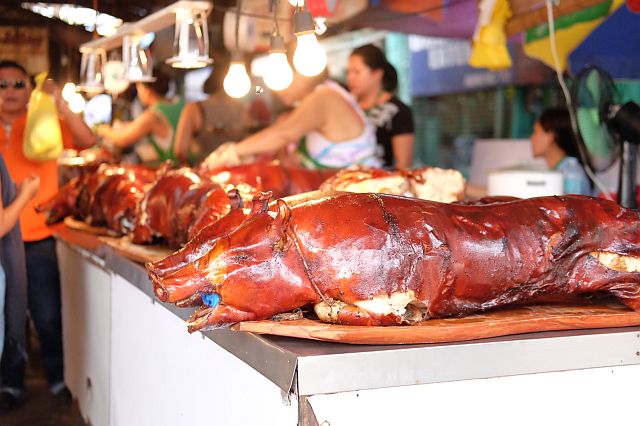
LECHON FOR DAYS at the public market of Carcar, truly worth the 40 kilometer trip from Cebu City!
NOTE: In the aftermath of a well-meaning travel advisory against the South of Cebu, I’m publishing this belated Halloween-themed, impromptu trip to just that area in question. I acknowledge that the threat is always present, always real, but that I have faith in my government to provide the necessary protection to both its visitors and citizens alike. After all, if we cease to explore and discontinue our way of life, the enemy has already won.
As with many journeys, this one starts with a craving.
“Carcar lechon naman tayo,” says Noel Angeles, best bud from college. He meant eating the infamous lechon, all crackling red skin and signature salty drippings right at the public market, 40 kilometers away from Cebu city.
We’ve done this trip before, he and I, and his wife Lynn and my goddaughter Ava, once before. I suspect Noel likes the stunning visual of arriving at the market’s entrance to be greeted by rows upon rows of fiery red roasted whole pigs, the minders tempting you with a bit of skin, torn fresh from the whole, glistening in the noontime sun. “Tilawi mam!” Come have a taste, they cry out, and you do. We usually end up with a kilo, drenched in Carcar’s secret
ingredient: the drippings from the roasting process (all of fat, salt, and lemongrass) are collected from the cooking and poured back into your order. The deadliest way to enjoy the famous Cebu lechon (or inasal, as our folks call it), one friend quips.
To eat, you make your way past ladies huddled over ample-sized pusô (hanging rice) laid out in their bukag (woven baskets). Make sure to stop by and watch one in action, weaving the heart-shaped receptacle from coconut leaves, which they manage to do in under 15 seconds.
A few meters away, several carinderias (eateries) allow your kilo or two, as long as you order your drinks and other side dishes from them. Huddled in a tiny formica table, we dunk our prize in vinegar made from tubâ (coconut sap).
On this second trip, I’ve arranged for a little extra. The local government can arrange a free guided tour of the town, and all I had to do was write them. We headed to the Carcar City Museum, in what was the city dispensary built in 1929, and a resplendent example of American architecture in the country, to meet Jingjing de los Reyes, the museum curator.
“Last week some school officials called us to inquire as to why they were not
invited to a party that was thrown here,” she shares as we enter the public pool and baths right behind the dispensary. Now empty, it once served as a recreational pool for the wealthy in the ‘20s, and then in a macabre twist: “The dressing rooms became torture chambers, and the prisoners of war were bound, gagged, and thrown into the pool to drown.”
“Of course we had no such party last week, but the officials insisted on seeing and hearing one, with people dressed in white, and music.”
The ghosts of the past come alive, quite literally, in this town proud of their spectres. Their stories are kept vividly real, too, with much effort from the local government unit and their information office.
By the time our, er, spirited journey took us to the miraculous tomb of Monsignor Camomot, a Carcar-born Archbishop who just might be the next Filipino saint, the inside of St. Catherine of Alexandria Church, and the tombs inside its walls, and a bit of kitsch at the Tupas funeral parlor and their quirky coffin-inspired furniture (fancy a selfie inside an upright coffin?), I had already made a mental note to not let this good thing, um, die.
(To book a Carcar tour, call Candice Acuña, City Information Officer at +63 998 5581081 or at +63 32 2313044 local 32)